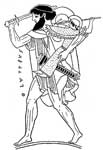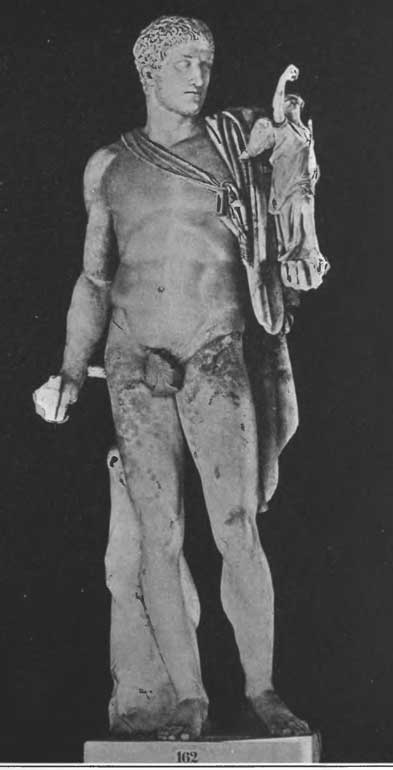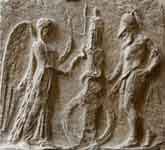.

Odysseus with the Palladium, vase painting
In Greek and Roman mythology, a palladium (gr. Palladion, Παλλάδιον ) was an image of immemorial antiquity on which the safety of a city was said to depend, especially the one that Odysseus and Diomedes stole from the citadel of Troy. It features in Graeco-Roman works such as the Aeneid. "Palladium" also refers to the specific statue that Athena erected of Pallas, daughter of Triton.
The Trojan Palladium was said to be the image of Pallas, whom the Greeks identified with Athena and the Romans with Minerva, and to have fallen from heaven in answer to the prayer of Ilus, the founder of Troy. Since Troy could not be captured while it contained this image, the Greeks Diomedes and Odysseus carried it off during the Trojan War. According to various versions of this legend it found its way to Athens, or Argos, or Sparta (all in Greece), or Rome in Italy. To this last city it was either brought by Aeneas the exiled Trojan (Diomedes having only succeeded in stealing an imitation of the statue) or surrendered by Diomedes himself. It was kept there in the temple of Vesta in the Roman Forum.
According to myth, the importance of the Palladium to Troy was revealed to the Greeks by Helenus, the prophetic son of Priam, and Diomedes and Odysseus made their way to the citadel in Troy by a secret passage and took the image. In this way the Greeks were then able to enter Troy and lay it waste using the deceit of the Trojan Horse.
"The most ancient talismanic effigies of Athena," Ruck and Staples report (see References below), "...were magical found objects, faceless pillars of Earth in the old manner, before the Goddess was anthropomorphized and given form through the intervention of human intellectual meddling."
In Late Antiquity, it was rumored that the Palladium was transferred from Rome to Constantinople by Constantine and buried under the Column of Constantine in his forum. Such a move would have undermined the primacy of Rome, and was naturally seen as a move by Constantine to legitimize his reign.

Diomedes with the Palladion, Glyptothek
See also

Nike and warrior in from of a column with the Palladium, Louvre Ma969
References
Carl Ruck and Danny Staples, The World of Classical Myth
| Ancient Greece
Science, Technology , Medicine , Warfare, , Biographies , Life , Cities/Places/Maps , Arts , Literature , Philosophy ,Olympics, Mythology , History , Images Medieval Greece / Byzantine Empire Science, Technology, Arts, , Warfare , Literature, Biographies, Icons, History Modern Greece Cities, Islands, Regions, Fauna/Flora ,Biographies , History , Warfare, Science/Technology, Literature, Music , Arts , Film/Actors , Sport , Fashion --- |
Retrieved from "http://en.wikipedia.org"
All text is available under the terms of the GNU Free Documentation License

